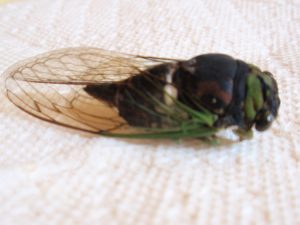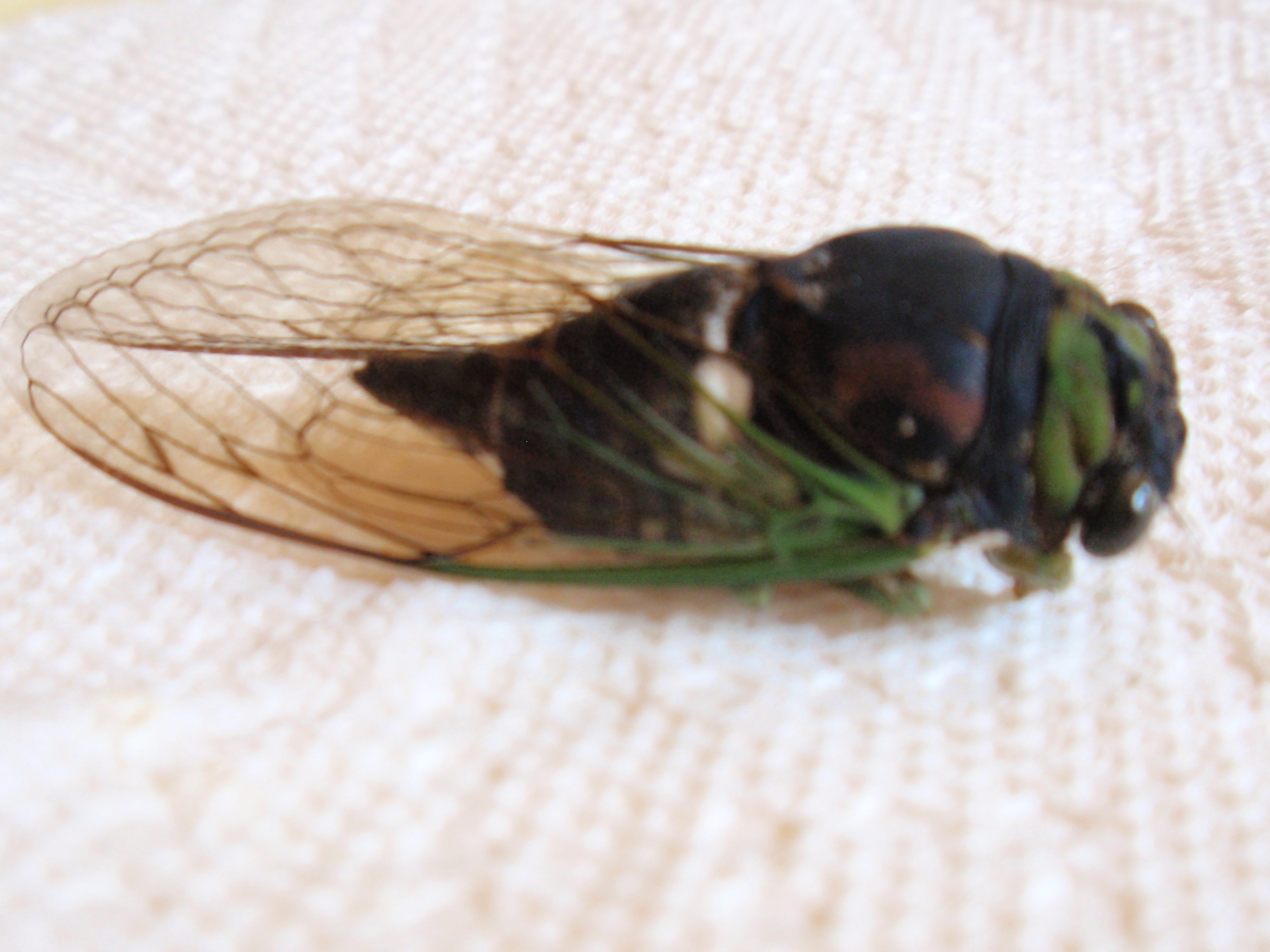
On June 28, I heard the first cicada of the year (FOY). It gave a single call. The next day, I heard one more call in the middle of the day. That evening, one sang first in the yard to the north, then one sang in my yard, and, finally, I heard one in the yard to the south. Was this the same insect moving or three different insects? What I did know was summer was on its way as at least one cicada had emerged from it life underground. Now, several weeks later, the excitement and noise is growing. Until just a few years ago, I heard the high pitched whirring song of cicadas every summer never realizing that different kinds existed.
Around here, the annual cicada (Neotibicen sp.) IS the sound of summer! Even children know the name of the creature making that noise or at least they think they know. Often called locusts, in reality, these insects bear no relationship to true locusts, not even close! According to a fact sheet produced by Penn State, early settler’s experienced a periodic cicada emergence and compared it to the biblical locust invasion; one possible explanation for the confusing common name. [1] The annual cicada making noise in my yard lives a vastly different lifestyle than its close relative the periodic cicada (Magicicada sp.) that do descend like a plague of locust.
Most easterners recognize the much more common annual cicada, an insects with a much shorter life cycle, usually between two and eight years. Since multiple broods exist, each summer starting in late-June and whining through September, one hears the annual cicada’s strident sound high in the trees.
Upon closer inspection, I learned that the annual cicada is NOT a single species but a collection of many species. You can hear the difference in the two clips. Up until recently, I never “heard” any difference. I only heard a sound I labeled cicada.
Please do not confuse the annual cicada with the periodic cicadas, a cicada brightly marked in reds and blacks, that only emerge as adults ready to breed after 13 or 17 years feeding on tree roots. You know it when you discover an emergence of periodic cicada. First, it happens much earlier in the season—May—than the annual cicada. Second, the noise made by the periodic cicada stretches beyond the human’s tolerance capacity for screeching, pulsing, whining, and loud noises! In my sixty plus years of living, only twice did the periodic cicada assault my hearing and each time I purposely made the effort to travel to the site of an emergence just so I could understand why people found the experience so fascinating and annoying. The penetrating noise makes me feel sorry for anyone who lives through an emergence.
Each year, somewhere in the country, one can find a periodic cicada emergence, but you had better do your research and be ready to travel if you want to experience an emergence. This year, they were supposed to emerge in my county, but to the best of my knowledge, nothing happened. [1] It does not surprise me as the Penn State Agricultural Department reference also explains in detail how to eliminate them from your area. I believe we are poisoning and bulldozing this species into oblivion.
When I “heard” the difference for the first time I decided to listen carefully. I wanted to sort out what was happening and what species I had locally. So, I went to the wonder of the internet and searched for cicada sounds. I learn that 40 species from many different genera within the family of Cicadas could be in our area. The most common and noisiest ones being from the insects in the genus Neotibicen. Just twelve annual cicada (Neotibicen) species can be found in the United States. Of these, five species (marked with an *) may be in Pennsylvania: Neotibicen canicularis*, N. linnei*, N. pruinosus, N. winnemanna*, N. latifasciatus, N. robinsonianus, N. lyricen*, N. tibicen*, N. similaris, N. superbus, N. davisi, and N. auriferous. [2] That should make it easy! Not so!
The first website offers a number of the sounds, but no details like the range for each species. [3] A second website offers songs and descriptive common names for species found in Florida. [4] A third site provides a worldwide collection of cicada, but fewer Neotibicens songs than the others. A fourth contains lots of information about cicadas worldwide, but no sounds. [5] A fifth has some songs, but the names were not the same as the other web sites and I had the impression this site still uses out of date names. You get the idea of the progress. Argh.
Every cloud has a silver lining, I still learned a lot! Typical of me, while poking around in the internet, I drifted off topic onto something related, tangential, but interesting none the less.
Humans seem to have an innate desire to label everything: good/bad, tasty/poisonous, friend/foe, relative/not, innocuous/dangerous. It is probably a carryover from the days when everything meant life or death. To understand the complexity of life, we need more, much more, than just a label. For example, years ago during my first night in Belize, a bird made a raucous repetitive call from over the houses in the Mayan village where we stayed. I asked a villager, “What is making that noise?” He replied, “The Night Bird.” To him, it posed no danger and offered no opportunity for nourishment. It needed no other name. I on the other hand keep a bird life list and needed to identify the sound, not to eat or to protect myself, but just to know. Instead of “Night Bird” knowing the name—plain chachalaca—I could picture the large brown chicken-like bird, notorious for making a loud raucous onomatopoetic call day and night. With a name, I could research everything known about this species; an opportunity not open to the villager. To know something, first it needs a name.
In an effort to understand the complexity of life, people worked out systems of classification. Early taxonomists used structural characteristics to combine like organisms together: the number and arrangement of male and female parts on a plant; the skeletal structure of animals. This style of taxonomy is called phonetics or taximetrics. Today, scientists use the system of cladistics, where organisms are sorted out by characteristics shared with a common ancestor. This creates a linear pattern of evolutionary relationships.
First introduced in the mid twentieth century, cladistics created upheavals as does any major change to the status quo. Long established groups, genera, families, and even orders changed relationships. Generally, bird books progress from the oldest families to the most recently evolved families of birds. Pick up any old bird book. Compare the old book with a new book and its order is drastically different due to the genetic studies that have rearranged clads. The new arrangements created a booming business in new field guides, each trying to make sure they have the most current evolutionary relationships. This succeeds in frustrating the old hands like me; now relegated to hunting through the book once more as opposed to knowing roughly where a species would fall within a book.
This is where the tangent touches the original topic. The naming and clad reshuffling is true with the cicadas, originally listed as Homopteras, a separate order given to cicadas, aphids, leafhoppers, and scale insects. Relative recently (1994) taxonomists placed cicadas and all of the homopterans into the order Hemiptera (true bugs) and they did away with Homoptera. Everything I learned as a kid changed and even discarded. Ouch!
Like all Hemipteras, cicadas have sucking mouth parts, jaws formed into a straw designed to pierce tissue. The cicadas use this straw for slurping the sap from plant tissue.
Any new idea has its disciples, detractors, and challengers. Recent research casts doubt on the proposed relationship of cicadas with Hemiptera, so I decide to leave the cicada taxonomy for someone else and just enjoy the insects for what they are and the joy the song brings!
My quest to identify the various species in my yard continued despite drifting off onto the tangent.
For weeks, I would take my laptop outside and listen to the audio pages of the various cicadas as I listen to the real deal in an attempt to match up the sounds. Then, one day, it all clicked. I realized I had at least three and probably four species in my yard.
I even figured out a relatively easy way to remember which was which, but that needs to wait for another blog as this one has gotten too long and I do not know if my readers even get this far. So, if you want to know how I separate my local species and what you may have in your neighborhood, ask in a comment, and I will proceed.
References:
[1] http://ento.psu.edu/extension/factsheets/periodical-cicada
[2] www.Bugguide.net
[3] http://www.mechaworx.com/Cicada/cicadavideos.asp
[4] http://www.entnemdept.ufl.edu/walker/buzz/c700fl1.htm
[5] http://www4.agr.gc.ca/AAFC-AAC/display-afficher.do?id=1229021431446&lang=eng
[6] http://www.thefreedictionary.com/neo- and Borror , Donald J. Dictionary of Word Roots and Combining Forms, Mayfield Publishing Company, Palo Alto, CA, 1960.
[7] http://ag.udel.edu/delpha/1158.pdf Molecular Phylogeny of the Homoptera: A Paraphyletic Taxon Carol D. von Dohlen,* Nancy A. Moran Department of Ecology and Evolutionary Biology, University of Arizona, Tucson, AZ 85721, USA Received: 8 July 1994 / Accepted: 16 November 1994


I would love to know how you identified the different species!
Your the first. If there is enough interest, I make a post. If not, I will send you the information in an email.
Count me in too. I love cicadas. They look so fierce and sound so lovely.
Great. So far I have three people interested. Once I hit 5, I’ll post it. If I don’t get 5, I’ll just email it to you.
I’m interested! Not sure we have more than one annual species here in my part of Texas. We don’t have periodic cicadas at all.
There are 5 species reported for Texas, but it is a big state. I’ll make sure you get the information so you can check it out.
I would love to know how you separated the species in your yard, and how I can do the same in mine. Thanks!
I thought you might!
Good post, but I’m not going to try to identify my cicadas.
Your missing out on some fun and it is relatively easy.
I am absolutely interested in knowing the specific species you’ve identified. I’ve always assumed the two different sounds in your recordings were from the same species, so I was so interested to read that they are NOT. Please enlighten me!
Hope you found my second post with details. What I provide is only a start, but it can be a fun thing to do!
Thank you for introducing me to Cladistics. Thanks, too, about your story on the NIghtbird. Everything is related; we learn. I have little patience for labeling people; maybe the early label makers just wanted to understand more and learn more. I am looking forward to part 2.